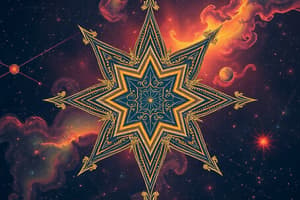Podcast
Questions and Answers
What is a nebula?
What is a nebula?
- A large cloud of gas and dust (correct)
- The remains of a high mass star
- A stage of a star's life
- A type of star explosion
What is a protostar?
What is a protostar?
The contracting cloud of gas and dust in a nebula.
When is a star born?
When is a star born?
When nuclear fusion starts.
What happens when a main sequence star runs out of hydrogen fuel?
What happens when a main sequence star runs out of hydrogen fuel?
Match the stages of a star's life cycle:
Match the stages of a star's life cycle:
What is a white dwarf?
What is a white dwarf?
What defines a neutron star?
What defines a neutron star?
What is a black hole?
What is a black hole?
What is a black dwarf?
What is a black dwarf?
Flashcards are hidden until you start studying
Study Notes
Life Cycle of a Star
- All stars originate from a nebula, which is a vast cloud composed of gas and dust.
- A protostar forms when gravity pulls together portions of the gas and dust within a nebula.
- The process of star formation begins when the temperature and pressure in a protostar increase sufficiently to trigger nuclear fusion.
- A star shines when hydrogen atoms fuse together, releasing enormous energy.
- As a main sequence star exhausts its hydrogen fuel, it will expand into a red giant or red supergiant.
Stages of a Star's Life
- Stars begin as diffused clouds of gas and dust known as nebulae, where the initial formation occurs.
- Gravity causes the nebula to collapse into denser clumps, leading to the protostar stage.
- During protostar formation, heat and pressure culminate in nuclear fusion, marking the start of a star's lifecycle.
- When fusion ignites, the star becomes luminous and enters the main sequence phase of its life.
- The subsequent transformation into a red giant or red supergiant depends on the star's available fuel and mass.
End Stages of a Star
- A white dwarf forms as the remnant core left when a medium-mass star sheds its outer layers in a planetary nebula.
- A supernova occurs when a red supergiant star reaches the end of its fusion processes and undergoes a catastrophic explosion.
- The remnants of high-mass stars result in neutron stars, which are extremely dense.
- A medium-mass star eventually becomes a black dwarf when it has cooled and ceased nuclear fusion.
- Black holes represent the end state of massive stars, characterized by an intense gravitational pull that prevents light from escaping.
Additional Terms
- Nebula: A large gas and dust cloud in space where stars form.
- Protostar: The earliest stage in the lifecycle of a star before nuclear fusion starts.
- Supernova: An explosive death of a star, often leading to a neutron star or black hole formation.
- Neutron Star: The dense remains of high-mass stars after a supernova explosion.
- Black Dwarf: The final state of a medium-mass star at the conclusion of its life cycle.
- Black Hole: An astronomical entity with a gravitational field so strong that not even light can escape its pull.
Studying That Suits You
Use AI to generate personalized quizzes and flashcards to suit your learning preferences.




